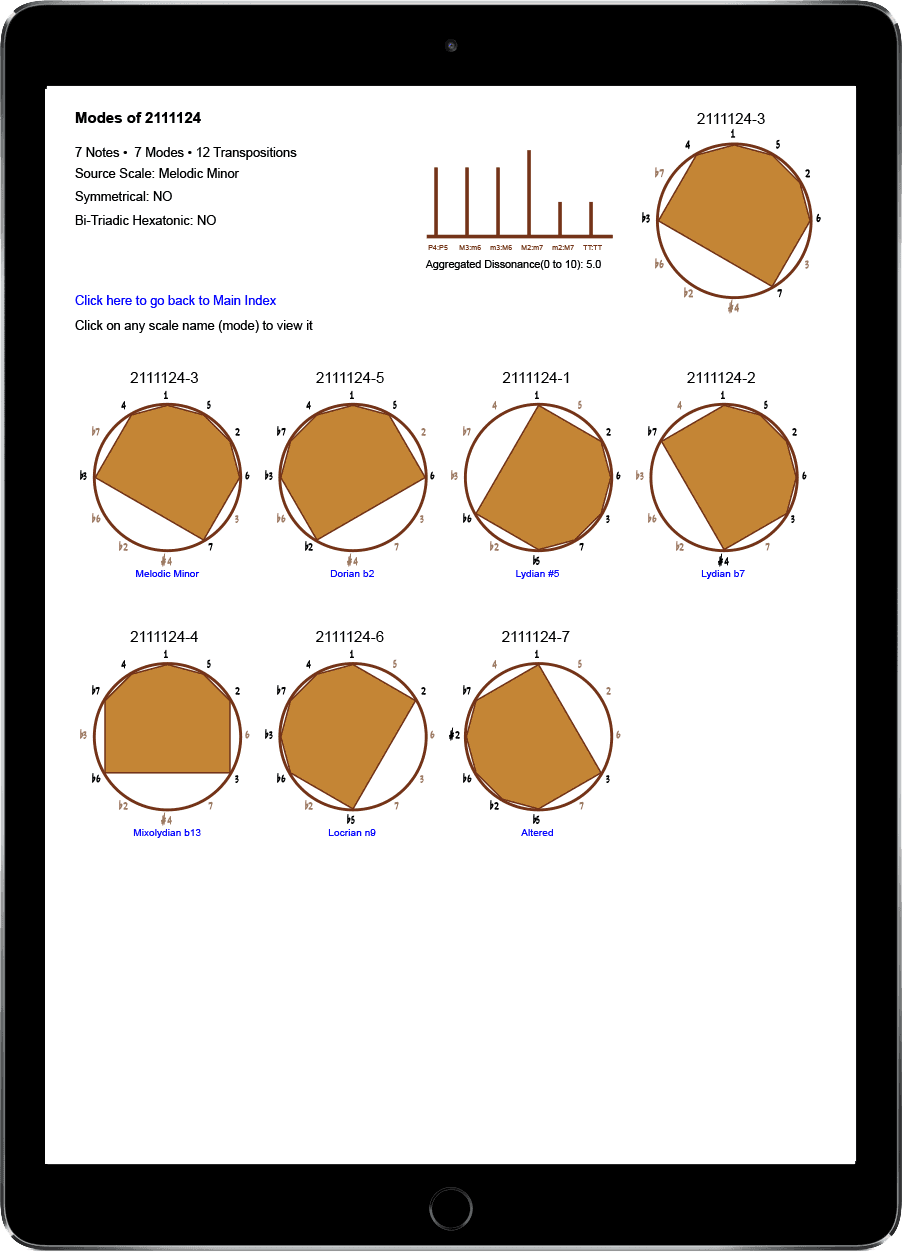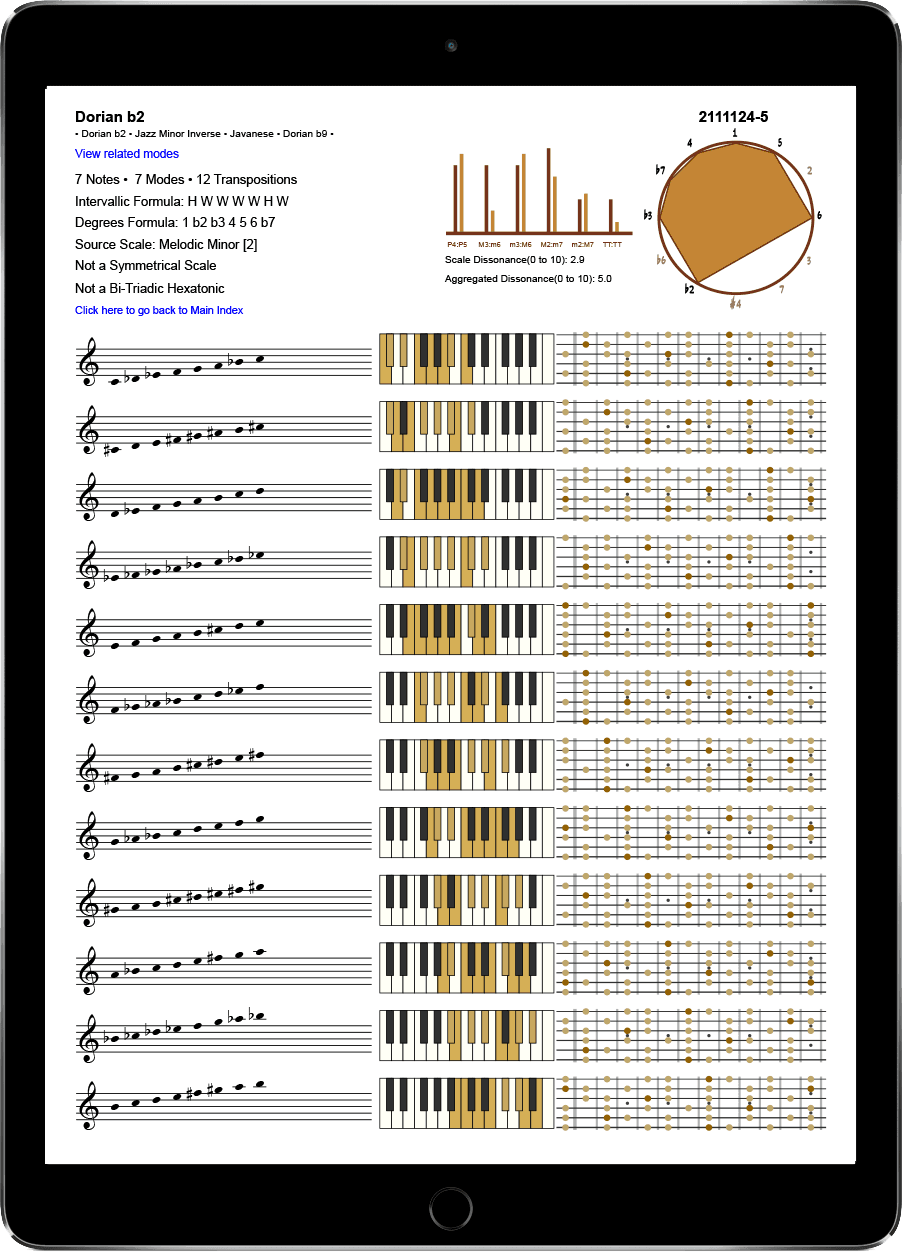The Universal Encyclopedia of Scales is a fully interactive PDF containing all 2048 scales in music, organized over the circle of fifths, with 2600+ pages of information.
The encyclopedia includes chapters on scale theory, several master indexes by mode count and note count, source scales, symmetrical scales, and hexatonic bi-triadic scales.
Each scale has its own individual page that shows the default name, alternative names, link to its Source Scale & Related Modes, amount of notes, modes & transpositions, intervallic formula, degrees formula, source scale, symmetry, bi-triadic hexatonic classification, a graph over the circle of fifths, an interval-content chart, and dissonance index values.
“There are 2048 scales in music, no more, no less. 12 of them are intervals (scales with only two notes), and 344 of the other 2036 scales are source scales”
A complete encyclopedia of scales has always been on every musician’s wish-list. There are many reasons why having a collection containing all scales in music fascinates us, but the most attractive one is that it is universal.

We all know that our twelve tone system (with only twelve different pitch-classes) must produce an exact amount of scales. A list with all possible scales in music must then be universal and unchanging. In fact, if well-organized, this list should offer much more than just a simple description of each scale. This list could show relationships between scales while cataloguing them based on different properties (symmetry, amount of notes and/or modes, source scales vs. modes of source scales, intervallic formulas, etc.)


With a complete encyclopedia of scales we can finally have the answers to many questions, such as:
How many scales are there in music and what are they?
Which scales are the source scales and what are their related modes? (What are the related modes of any scale?)
Which scales are symmetric?
How many scales are there with only one (or two, three, etc) mode(s), and which ones are they?
Which scales are pentatonic or bi-triadic hexatonic or truncated, etc.?
What is the scale represented by a specific intervallic formula?
What is the interval content of any scale? How dissonant or consonant a scale is?
How many modes does any one scale produce?
Three Biggest Challenges to Solve before creating a Universal Encyclopedia of Scales
1. Defining Scale, Mode, Source Scale & Related Modes
Establishing a precise definition of scale is not a trivial matter, yet it is of the utmost importance that we do so, since it will be essential to understand the information presented.
Defining a mode is actually much harder since the most- often-used definition (which is: changing the starting note of a scale) does not account for symmetry and always yield as many modes as notes in the scale (which is not true for symmetrical scales, such as the Messiaen V, or a dom7b5, or the augmented triad, etc.
Every scale produces a number of different modes of itself acting as a source scale of any of these modes. A strange properties of modes is that a scale must be (for consistency in scale theory) a mode of itself. The set of all possible modes obtained from a source scale (including itself) is known as related modes.
2. Cataloguing & Naming Scales
One of biggest challenges when creating an encyclopedia of scales is naming, cataloguing and organizing all possible scales in music in a useful manner.
We take for granted that a scale’s name says something about the scale, but that cannot be further from the truth. A scale name very rarely informs us about the properties of the scale. Yet we still need to name entities in order to incorporate them into our world.
Historically, scales have been named capriciously most of the time. This method works well when we are dealing with just a few scales. One could perfectly memorize the names of the seven modes of the Major Scale: Ionian, Dorian, Phrygian, Mixolydian, Lydian, Aeolian and Locrian, even though these names do not in any way tell us anything about the scales they represent or how they relate to each other.
Naming scales capriciously is very effective for often-used scales but is not suitable for the entire universe of scales.
Another problem is that a scale is often known by various different names, depending on your musical background and region in the world you might be familiar with one of the names but not the others. Some people called {C D E F# G A Bb, C = root} the Lydian Dominant others, the Lydian b7, and also Mixolydian #4
It is worth noting that scale names are root independent
3. Finding All Scales In Music
A universal encyclopedia of scales makes sense only if it contains all possible scales in music, listed, organized and accessible by using different search criteria.
The Universal Encyclopedia of Scales by mDecks Music
In The Universal Encyclopedia of Scales by mDecks Music we have used a technique that graphs scales over the circle of fifths.
This technique in conjunction with mathematical principles allowed us to reveal, organize and catalogue the entire universe of musical scales.
The Universal Encyclopedia of Scales contains all 2048 scales in music (2036 scales with three or more notes plus 12 scales of two notes also known as intervals)
Since graphing allows us to determine which scales were related modes of each other, we were able to establish the amount of source scales of three or more notes which is 344 (not considering intervals which are trivial scales of two notes)
The amount of scales in music will never change. It will always be 2048 (in a twelve tone system). The catalogue ID used in the encyclopedia is also universal and eternal. Standard names for scales including the three other alternative names were created by using different naming techniques consistent with music theory (such as Omit, Add, Truncation, etc) that facilitate the recognition of a scale based on well-known scale names.
To find out more please visit https://mdecks.com/theuniversalencyclopediaofscales.phtml


with regard to content, is there any difference between the scope of content in the encyclopedia and that presented in tessituria pro? my reason for this question is that there is a significant difference in price which I think will be a deciding factor for the majority of potential customers.( tessituria pro being at a significantly lower price point compared to the PDF reference material)
LikeLike
Hi Shaun, good question. In the encyclopedia we have done all the work for the user so they don’t need to learn any software to access the information. Many Tessitura users are overwhelmed with the many possible combinations and the steep learning curve. So we decided to create an easy to use pdf where you can access the same information without the need to learn how to do it. Also for the encyclopedia we developed a pretty robust naming system for scales so now every scale has a default name and three alternative names that all make sense musically. FYI in Tessitura most scales are unnamed which works against one’s intuition that helps correlating scales with their names. We are developing a new version of Tessitura using these same concepts but for now the encyclopedia it’s more gratifying to use in my opinion.
LikeLike
Thank you for your comprehensive reply, I actually use tessituria pro so have a pretty good grasp of the potential issues some ( probably the majority of) users would face in using the software, (as an aside I am very impressed with the quite recent update to mapping music, harmony pro)
LikeLike